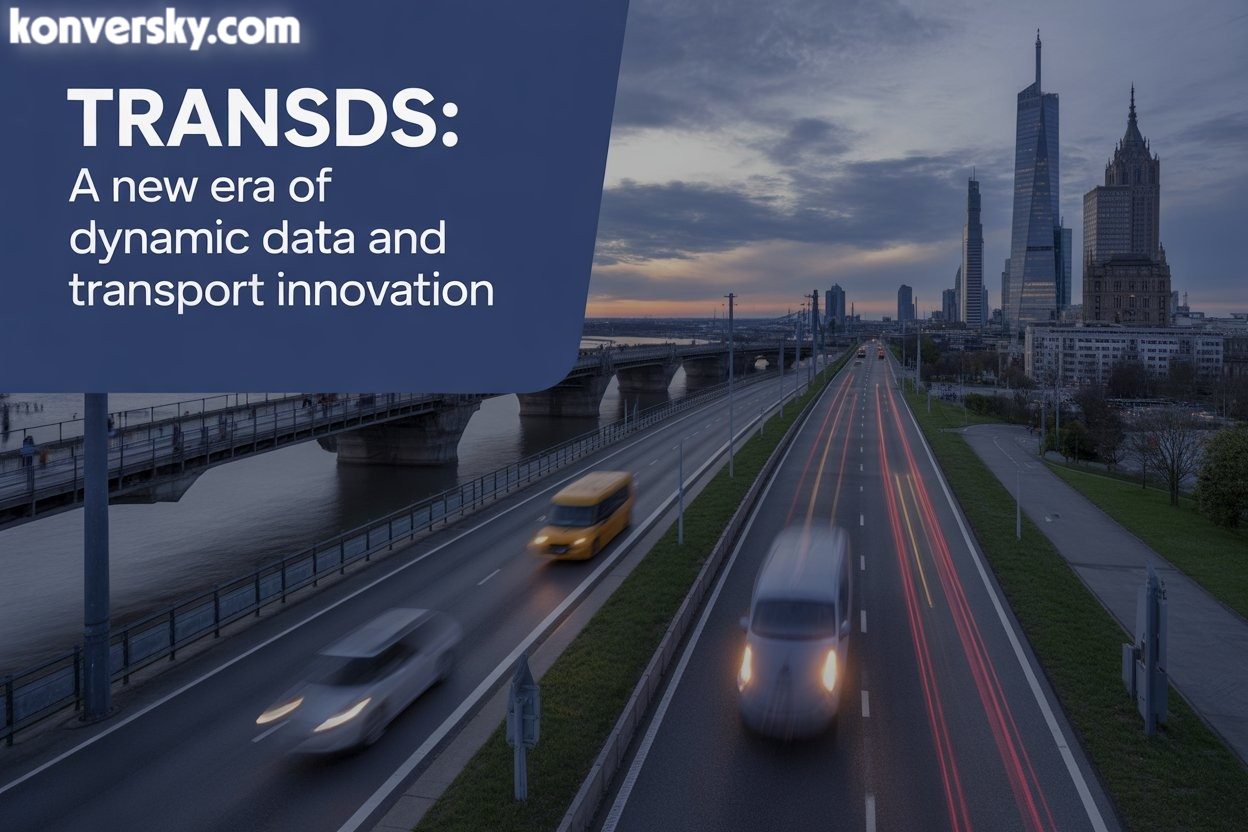Introduction – The Rise of a Smarter, Connected World
Technology is reshaping how we connect, share, and move across the world every single day. Data systems and transportation networks are becoming deeply linked, creating faster, smarter, and more reliable ways to manage both digital and physical movement. This connection is driving industries to think beyond traditional systems and embrace real-time interaction.
As global cities expand and industries digitalize, the demand for smooth coordination between data and mobility continues to rise. The focus has shifted from static systems to flexible models that can adjust instantly to change. This evolution marks the beginning of a new technological age built on adaptability and speed.
At the heart of this transformation stands Transds, a concept that unites data intelligence with modern transportation. It builds intelligent systems that sense, learn, and act in real time. By merging digital insight with movement, Transds paves the way for a smarter, more connected, and highly efficient future.
What Exactly Is Transds?
Transds is a modern concept that blends data intelligence with real-world mobility. It represents a shift toward systems that think, adapt, and act in real time. At its core, Transds focuses on building smooth connections between digital information and physical movement.
The term carries a dual meaning. On one side, it refers to Transitional Data Structures, which allow data to change and adjust across different platforms without losing value. On the other, it means Transport Dynamics Systems, which use automation, sensors, and analytics to make transportation faster and smarter.
Both ideas share the same goal — flexibility, speed, and intelligent communication. Together, they shape a world where data flows easily, and transport responds instantly. Transds is not just a tool but a forward-thinking approach that bridges technology, movement, and innovation.
How Transds Transforms Data Systems
Traditional data structures often work within fixed rules. They store and share information in strict formats, which makes adaptation difficult. When systems change, these old frameworks struggle to adjust quickly, leading to delays and gaps in communication. As a result, real-time decision-making becomes limited, especially in industries that depend on speed and precision.
Transds changes this by introducing flexibility and instant transformation. It allows data to shift shapes and formats automatically, depending on the need. This means that information can move freely between systems without complex adjustments. Through adaptable structures, Transds ensures that businesses always have updated and accurate data at their fingertips.
In finance, Transds enables banks to analyze market movements in real time, helping investors act faster. In healthcare, it connects patient data from different departments, allowing doctors to make quicker and more reliable diagnoses. By turning rigid data systems into living networks, Transds drives smarter operations and seamless information flow across industries.
Transds and Smart Transport: Innovation on the Move
Transportation is entering a new age of intelligence and automation. Traditional systems that once relied on fixed routes and schedules are now being replaced by networks that think and adapt. Transds plays a central role in this shift, connecting vehicles, infrastructure, and data in real time to create a smoother, smarter flow of movement across cities.
Through integration with smart city frameworks, Transds links sensors, IoT devices, and cloud platforms to manage traffic and energy use efficiently. It enables dynamic routing, where vehicles adjust paths instantly based on congestion, weather, or passenger demand. This coordination builds a network that runs on insight rather than guesswork.
The results are clear—less congestion, reduced fuel waste, and improved public transport reliability. Electric buses charge during low-demand hours, delivery fleets avoid busy zones, and ride-sharing systems operate more efficiently. By merging automation, connectivity, and sustainability, Transds transforms transportation into an intelligent ecosystem built for the future.
Key Features That Make Transds Stand Out
Transds stands apart for its ability to blend intelligence, adaptability, and precision in one framework. Unlike static systems that struggle with constant change, it evolves in real time, responding to new data and shifting environments with remarkable speed and accuracy. This adaptability allows organizations to manage complex operations smoothly, even when conditions change unexpectedly.
Another powerful feature is its real-time synchronization. Transds ensures that every connected platform, device, or network stays updated without delay. Its context awareness enables it to understand not just data, but the meaning behind it, leading to smarter insights and faster actions across industries.
Security and scalability also define Transds. Built with robust encryption and flexible design, it grows with expanding needs while keeping information protected. Additionally, its cross-industry compatibility means it can function across finance, transport, healthcare, and beyond. Through continuous learning, it refines its own processes—making Transds not just efficient, but constantly improving with every interaction.
Real-World Applications of Transds
Transds has quickly become a driving force behind smarter and more efficient industries. Its real-time adaptability and intelligent data flow make it suitable for solving modern challenges across multiple sectors. From healthcare to sustainability, its presence is shaping how systems operate and connect every day.
In healthcare, Transds enables instant data sharing between devices and professionals. Doctors can monitor patients in real time and make quick, informed decisions. Similarly, in retail, it personalizes customer journeys while optimizing supply chains for faster delivery and reduced waste.
In manufacturing, Transds supports predictive maintenance by analyzing machinery data before breakdowns occur. It also boosts production efficiency through automated adjustments. Meanwhile, urban mobility systems use Transds to manage traffic, design smart routes, and reduce congestion. In sustainability efforts, it ensures energy is used efficiently and resources are managed responsibly. Altogether, Transds transforms complex operations into streamlined, intelligent networks that benefit both industries and communities.
Benefits of Embracing Transds
Adopting Transds offers a powerful leap toward smarter, faster, and more dependable operations. It blends automation with intelligent analytics to create systems that work seamlessly and adapt instantly. Through this transformation, businesses gain greater control, speed, and innovation in every process.
One major advantage is enhanced productivity. Transds reduces manual tasks through automation, allowing teams to focus on creativity and strategy. At the same time, its smart analytics deliver deep insights, helping organizations make faster and more informed decisions. This leads to smoother workflows and stronger performance across all levels.
Additionally, Transds ensures improved user experiences with real-time responses and reliable data exchange. It minimizes data loss, strengthens system stability, and promotes sustainability by optimizing resource use. Ultimately, embracing Transds supports both innovation and long-term growth—empowering industries to move confidently into a more connected and efficient future.
Challenges and Considerations
While Transds offers remarkable potential, adopting it comes with certain challenges that require careful planning. Integration is one of the biggest hurdles, as merging Transds with older systems can be complex and time-consuming. Transition costs may also rise due to infrastructure upgrades and the need for advanced tools to ensure smooth operations.
Another major concern is data security and governance. Since Transds handles vast, real-time information, maintaining privacy and regulatory compliance becomes essential. Organizations must implement strong security protocols and ensure that all data transfers remain transparent and traceable.
Moreover, the success of Transds depends on skilled professionals and modern infrastructure. Finding experts who understand its technical depth is crucial. At the same time, maintaining a balance between flexibility and strict regulations can be challenging. However, with the right strategy, training, and governance, these obstacles can be transformed into opportunities for long-term growth and resilience.
The Future of Transds: Where Innovation Leads Next
The future of Transds is moving toward a smarter and more connected world. As technology advances, adaptive systems are beginning to rely heavily on artificial intelligence and machine learning. These tools allow Transds to predict changes, adjust data flows instantly, and make operations faster and more efficient. This shift is setting new standards for how industries manage information and mobility.
At the same time, blockchain technology is adding a new layer of trust and transparency. It ensures that every transaction and data transfer within Transds networks remains secure and verifiable. This combination of AI precision and blockchain reliability will shape the foundation of next-generation data systems.
Looking ahead, the focus will be on creating unified global standards for smart data and transport integration. The vision of fully intelligent cities powered by Transds is becoming more realistic each year. With continuous innovation, this technology will not only connect systems but also redefine how society interacts with information, movement, and sustainability.
Conclusion – Shaping Tomorrow’s Connected World
Transds is revolutionizing how data and transport systems work together efficiently. It connects digital networks with physical mobility, creating smarter, faster, and more responsive solutions.
By combining real-time adaptability, intelligence, and sustainability, Transds is setting new industry standards. Organizations and cities can now optimize operations, reduce waste, and enhance user experiences simultaneously.
Embracing Transds means embracing progress, innovation, and a connected future. Those who adopt it today will lead the way in building a smarter, more sustainable world. The journey toward fully integrated systems has just begun, and the possibilities are vast.

